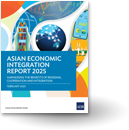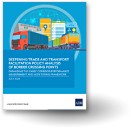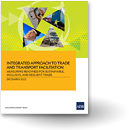Your Questions Answered: What is the Trade Finance Gap and Why Does it Matter?
Steven Beck, the Head of ADB’s Trade and Supply Chain Finance Program, answers questions about the trade finance gap in Asia and around the world, based on ADB’s Trade Finance Gaps, Growth, and Jobs Survey.
The pandemic has had a devastating impact on trade and the trade finance that powers it to create jobs and reduce poverty. It highlighted the need for deep changes in the trade finance system to close the gap in the number of those needing trade finance and those receiving it.
What is trade finance and what is the trade finance gap?
Trade finance provides financing and risk mitigation that helps produce and move goods to markets. This is critical for the economic growth that creates jobs, delivers medical technology and other goods, and improves peoples’ lives.
The trade finance gap is the unmet demand for trade finance and is calculated based on rejected applications for trade finance funding. From the perspective of global banking, trade finance is a low-risk form of finance with very low default rates, which makes the sizeable gap difficult to understand.
Trade finance supports about 80% of global trade through a variety of financial instruments including letters of credit, trade loans, guarantees, and insurance. Without trade finance, global trade would grind to a halt. In 2020, the value of trade finance transactions supported by major global banks was estimated to be around $9 trillion.
Why does the trade finance gap matter?
As stated by the United Nations and the International Chamber of Commerce, without sufficient levels of trade finance, the world will not be able to realize many Sustainable Development Goals. Trade finance underpins economic growth. On a more micro level, trade finance helps ensure that buyers get what they paid for and sellers get paid for the goods they produce. The trade finance gap hits hardest on small and medium-sized enterprises, which are the top drivers of growth and jobs, especially in developing countries. These businesses make up about 90% of companies. While they accounted for 41% of applications for trade finance, SMEs made up 52% of rejections in 2020. The gap is also particularly difficult for women-led businesses with 70% of their applications either partially or fully rejected.
Is the trade finance gap growing or shrinking?
The trade finance gap is growing. The gap was estimated by ADB at $1.5 trillion in 2018 and had risen to $1.7 trillion by 2020. It is now estimated to have topped $2 trillion due to rising risk aversion and inflation eating into lending limits. International lending agencies are responding, lending their AAA credit rating to transactions, which allows greater participation by lenders who might otherwise be constrained by internal risk or lending limits. The annual support provided by ADB increased by over 40% in the past two years, from around $5 billion in 2019 to over $8 billion in 2021.
What are the biggest reasons for the trade finance gap?
Demand for trade finance fell during the pandemic amid an overall global trade contraction. But at the same time, bank appetite for risk fell on what was perceived to be an increased risk of lending during the crisis. That led to a larger gap despite the fall in demand.
In addition to an unstable economic environment amid widespread predictions of recession, which are driving the private sector to reduce credit lines that support trade, inflation has cut into bank lending limits, with the value of limits now covering less trade as commodity prices rise.
Combine those issues with other systemic difficulties, such as the cost, complexity, and risk associated with anti-money-laundering compliance requirements against relatively low returns, and the attitude of many financial institutions considering trade finance to smaller companies is: “Why bother?”
Can the trade finance gap be reduced or eliminated and if so, how?
The trade finance gap can be eliminated. Multilateral development banks need to actively participate in global trade finance markets to reduce gaps. Billions of dollars’ worth of trade and development take place because of that support. But multilaterals need to work themselves out of a job, and replace themselves with private-sector counterparts. Direct participation in the markets is only a stopgap measure. And so, mobilizing private sector finance is an important part of what ADB’s Trade and Supply Chain Finance does.
To address core issues that could materially close the gap, the banking sector needs to take the Trade Finance Register that ADB started 10 years ago to the next level. The default and loss statistics provided by the register prove that, even in the most challenging markets during crisis, trade finance is a relatively low-risk business. By cooperating to inject more robust and granular data, banks could demonstrate to risk managers and regulators that capital allocations to trade finance should increase and capital costs should decrease. This would help close the gap materially.
There is an urgent need to digitalize trade. A range of issues could be addressed by bringing trade into the digital world. Through digitization comes transparency and a flow of data. This data can provide the information required to bring more financing to SMEs, enhance financial crimes detection, and help verify environmental standards through the supply chain. For digitization to become reality banks, companies, governments, industry associations, and regulators need to coalesce under the Digital Standards Initiative, housed under the International Chamber of Commerce, to agree common standards to enable a seamless digitalized trading system.
We’ve known about the trade finance gap for decades and it is time to put what we know about fixing it to work. It is a sector that has been ignored for far too long. Even the shakiest credit risks among consumers or large companies can find credit and yet the growth and jobs that would be created by extending more trade finance is missing. It is high time that is corrected.
Original article was published at the Asian Development Blog and duplicated here with permission from the author. *




